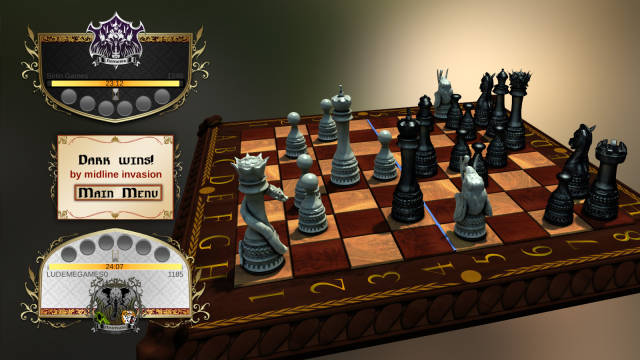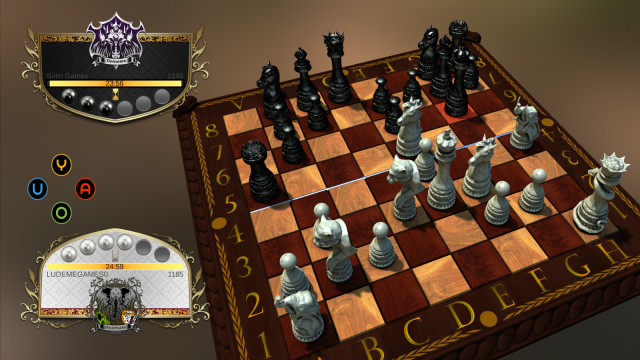
That hasn't stopped fans and addicts from tinkering with the game over the past 10 centuries. The changes have usually been small and insanely specific: one variant reverses the pawn's abilities—i.e. diagonal movement, forward capture—while another variant boosts the board size to 9x9 and adds a bishop/knight combo "prime minister" piece. These various incremental tweaks have never stuck around in competitive play, however, which might be why Chess 2 has staked its hopes on a far more staggering update.
The basic rules for Chess 2 have been floating around the Internet for over three years, accessible to anyone with a printer and a standard chess board. But the game's big, splashy, mass-consumption debut came this week through a free-to-play download on the beleaguered Ouya game console. The result will certainly get more people playing—and possibly even loving—Chess 2, but this digital edition makes a mess of laying out the new rules' plush red carpet.
Rushing and wagering
Before picking up an Ouya controller, you'll want to study the game's rule changes. The first and easiest to understand is an additional win condition. You can still win the classic way—by trapping your opponent's king in a checkmate—but bolder players can also win by sending their king into the opponent's half of the game board (i.e. past the first four rows) without being in check.
This "midline invasion" helps speed up the sometimes glacial pace of standard chess, but what's notable is how elegant that speed-boost feels. You might think that the ability to dash to victory, Braveheart-style, would turn Chess 2 matches into five-turn rushes, but taking a king out of the cushy, protected backline naturally leaves it much more exposed to a focused counterattack. It's a risky strategy that often requires sacrificing your own pieces for a precious one-row advantage for your king or setting up a football-like defensive line formation to protect his advance.
On its own, the midline invasion rule is a nice fit for any chess game. It throws a nice, easy-to-grasp curveball into the same tired old chess strategies. The other tweaks in Chess 2 are a little more out-of-the-ordinary, though they have their own appeal as well.
Take dueling. Both sides start games of Chess 2 with three betting tokens, which come into play whenever a piece is captured. The defender (i.e. the person controlling the captured piece) can bid anywhere from zero to two of these tokens in secret, and the attacker does the same. If the defender outbids the attacker, both battling pieces leave the board (the defending piece is still captured no matter what).

I've enjoyed some of the late-game opportunities that good dueling play can afford, but there's just too much conditional logic and rule-wrangling involved to keep track of all the wagering possibilities. For starters, you have to remember that a weaker piece defending against a stronger piece (in pawn->knight/bishop->rook->queen order) requires an extra token of tax before the duel begins. Worse, if a defender tries and fails to bluff an attacker, the attacker can then either claim a bonus token or destroy one of the defender's. Still with me? Mix all that up with the ability to win new tokens by killing pawns, and you might as well break out a spreadsheet to plan out your dueling strategy.
Meet the new armies
The final change to the Chess 2 formula comes in the pieces themselves. Before a game begins, each player chooses from one of six different armies of pieces. With the exception of the old standby "Classic" set, these armies all modify certain pieces with new abilities, adding an element of differentiation between players to what was previously an almost perfectly symmetrical game. It seems natural that the lead designer's resume includes fighting video games; the "character selection" here makes Chess 2 resemble Chess Fighter.
The "Nemesis" and "Empowered" sets, with nearly identical pieces to the Classic, are the easiest for newbies to test out, though not for lacking ambition. The Nemesis queen can neither capture, nor be captured by, anything other than a king, letting her dance around the board merrily. Nemesis pawns can now move "toward" an enemy king, meaning they can make lateral or diagonal moves depending on position. The Empowered set gets a mix of boost and hindrance; its bishops, knights, and rooks can share each other's movement abilities when adjacent (not diagonally, though), while its queen is stuck with wimpy, one-square-only moves like the king.
Things start getting weird with the "Reaper" set, whose queen and rooks can teleport anywhere on the board in a single move (though the rooks can't capture or be captured by other pieces, and the queen can't capture on the opponent's back row). Go for the "Two Kings" set, and you replace your queen with a second king. That doubles both your checkmate risk and your "midline" win condition, but in exchange you get an odd, king-only move as a bonus at the end of every turn, not to mention a new "whirlwind" king attack that removes any piece, friend or foe, in either king's one-block radius.
But wait, there's more! The "Animals" set is the wackiest, modifying the abilities of the knight, bishop, rook, and queen by reducing their range but increasing their flexibility. The rook—excuse me, elephant—can only capture pieces by rampaging three spaces in a row, through both friendly and opposing pieces, for instance.
I'm tempted to lead off army analysis by saying I'm not really sold on the Animals set being anything more than an aggressive lark. Because its pieces all suffer from reduced range, all of its best powers are avoidable by default if the opponent simply plays conservatively. But that would imply that I don't appreciate what Chess 2 does in offering different entry points to entice different styles of play. So what if the Animals aren't my cup of tea? Reaper astounds me with its strategy potential, particularly in the uncapturable, transportable "ghost" rooks. They are nothing more than nuisances, used to block and frustrate (I love them).
Two Kings fascinates me for a seemingly opposite reason: how it amps up drives, on both sides, toward a midline victory, with kills and captures now at the forefront. The Two Kings army seems so limited without a queen, but the bonus move it enjoys after every turn gets my chess heart racing. Then I watch as players overpower my new favorite armies with surprises like Empowered rook-knight rushes, Nemesis-powered "can't-hurt-me" queen dances, or even Classic teams carving me up with good ol' strategy. It all makes me want to jump back in and see what just one more matchup brings.
Has Chess 2 nailed every balance issue imaginable? Probably not. Asymmetry, by default, breaks this game's claim on the word "chess." And if anything is going to speed this remix toward near-perfection, it won't be a small pool of badly informed Ouya players.
A flawed Ouya conversion

These new rules are a lot to take in for new players. As such, you might hope Chess 2's video game version would provide the ultimate stepping stone, ready to instruct and guide terrified beginners. Sadly, you might as well hope for things like Santa Claus and a new unicorn while you're at it.
The best things I can say about the Ouya implementation of Chess 2 is that my online games have yet to crash. Single-system multiplayer is also bug-free and free free forever. That's different from the online matches, which require you to pay a small fee per match after the first 30 (it works out to about 7 cents per online game, depending on how much you pay at once).
Everything else about the Ouya version is incredibly bare bones, though. Other than an extremely dense video tutorial, Chess 2 doesn't offer any help to beginning players. There's no pause menu with lists of each army's powers, nor an info box that gives a mid-game reminder of how all of these crazy new pieces move. There's no tool to assist in the nitty-gritty of the complicated wagering math system. Starting out, you'll probably need to lean on a written version of the rules on a printout or iPad or something rather than anything built into the game.
Assuming you memorize the rules, you still must contend with overly shiny 3D piece models that are often hard to distinguish from each other. There's also no way to review previous moves in a Chess 2 match, in case you miss something in an online match or want to review how a game has gotten to the current position. Then there's the sluggish Ouya, which adds an annoying delay to every joystick tap around the board, not to mention a painful 15-second "thinking" delay on games against the AI. You'd be wise to ignore the AI matches altogether, really, with no difficulty slider beyond "crushingly dumb."
But the worst omission by far is the lack of any worthwhile online matchmaking, as the game forces players into random matches with no friend list, no win/loss/ragequit stats, and no way to communicate with your opponent. Thankfully, the combined pool of people who 1) own Ouyas and 2) play Chess 2 is pretty slim at the moment. If you want to challenge a specific friend, just synchronize your game-starts, and you'll probably luck out. Sloppy, but hey, that's the Ouya way.
There's also the soundtrack, made up of a single repeating hotel lobby piano ditty that will have you clawing your ears out before long. At least that can be muted.
None of this was enough to totally overwhelm the surprising fun I've had rewiring my brain for the new ruleset and strategies presented in Chess 2. Still, this is just about the sloppiest video game translation imaginable for those clever rule changes. Quite frankly, I hate this Ouya take, and I won't be loading it again until its issues are rectified. Despite the technical frustrations, I'm starting to consider knitting some elephant and tiger hats for my real-world chess set.
The good:
- The new armies and midline invasion rules, which have emerged from years of testing with many interesting entry points to rediscovering chess.
The bad:
- The wagering mechanic, whose strategy potential comes with too much micromanagement to feel as elegant as chess itself.
The ugly:
- The Ouya implementation, whose only positive is that it doesn't crash.
Verdict: You'll want to play around with Chess 2's interesting new armies, but you're better off decorating an old chess set—and printing the rules—than bothering with the current Ouya version.
reader comments
72